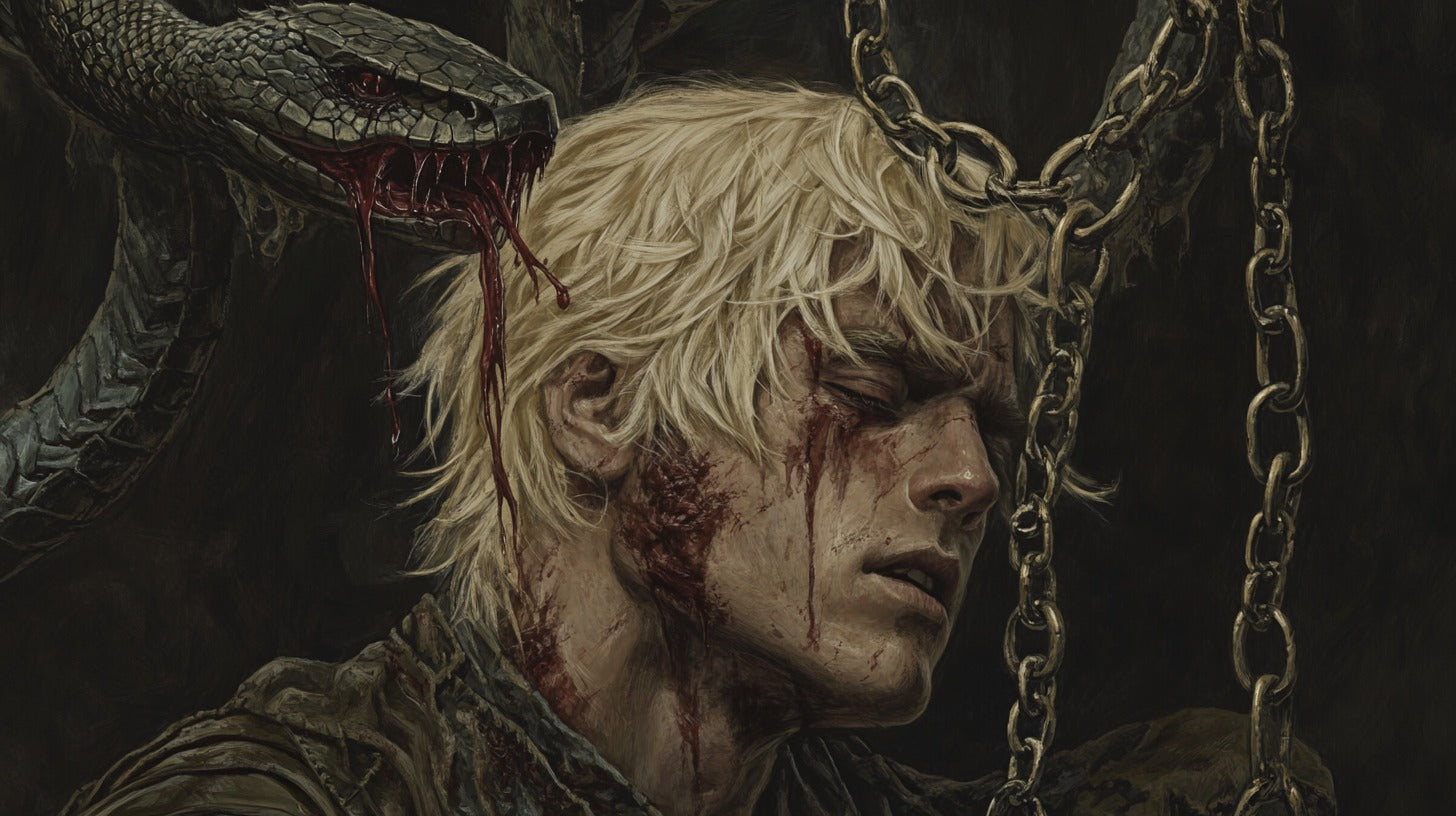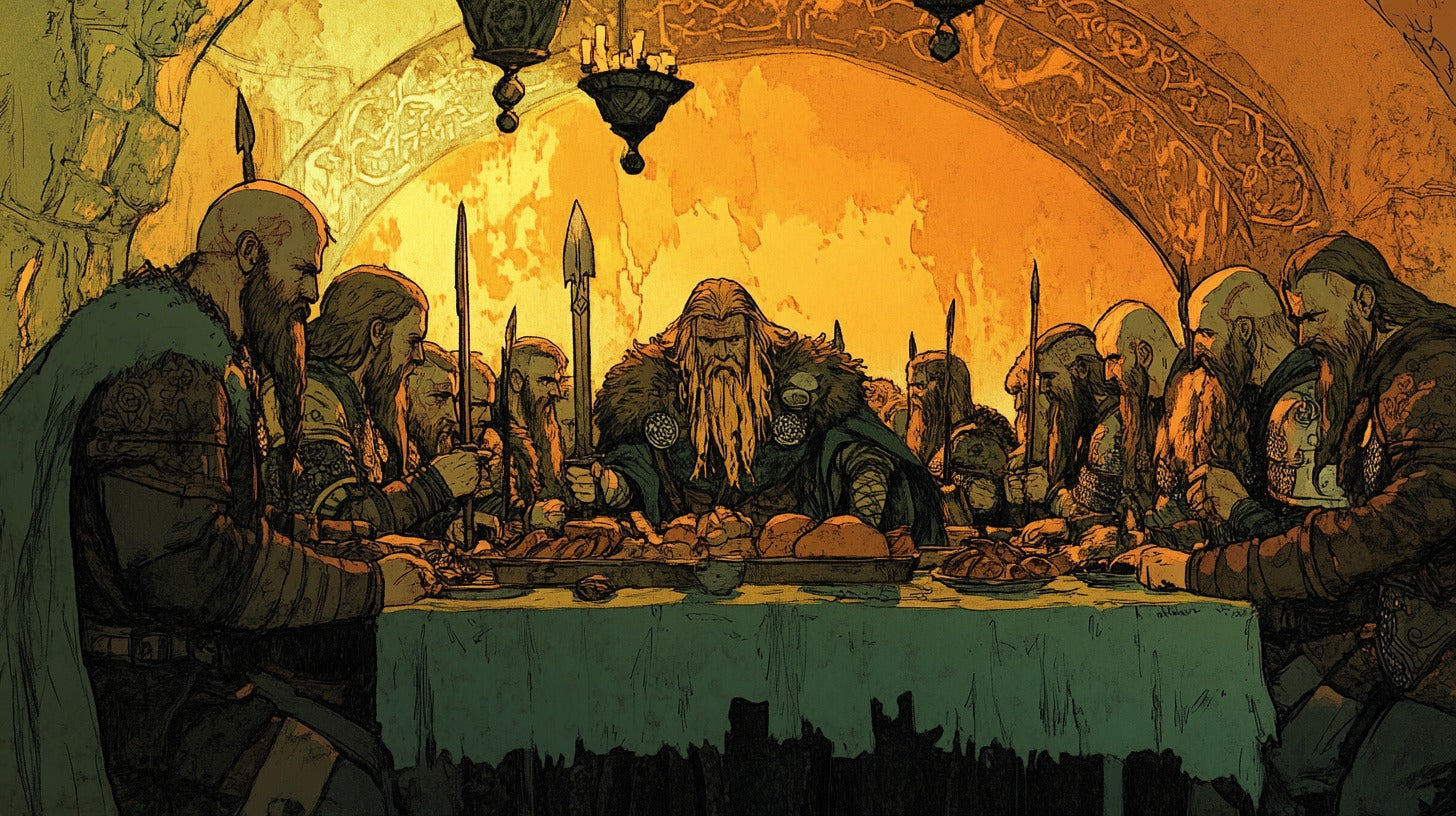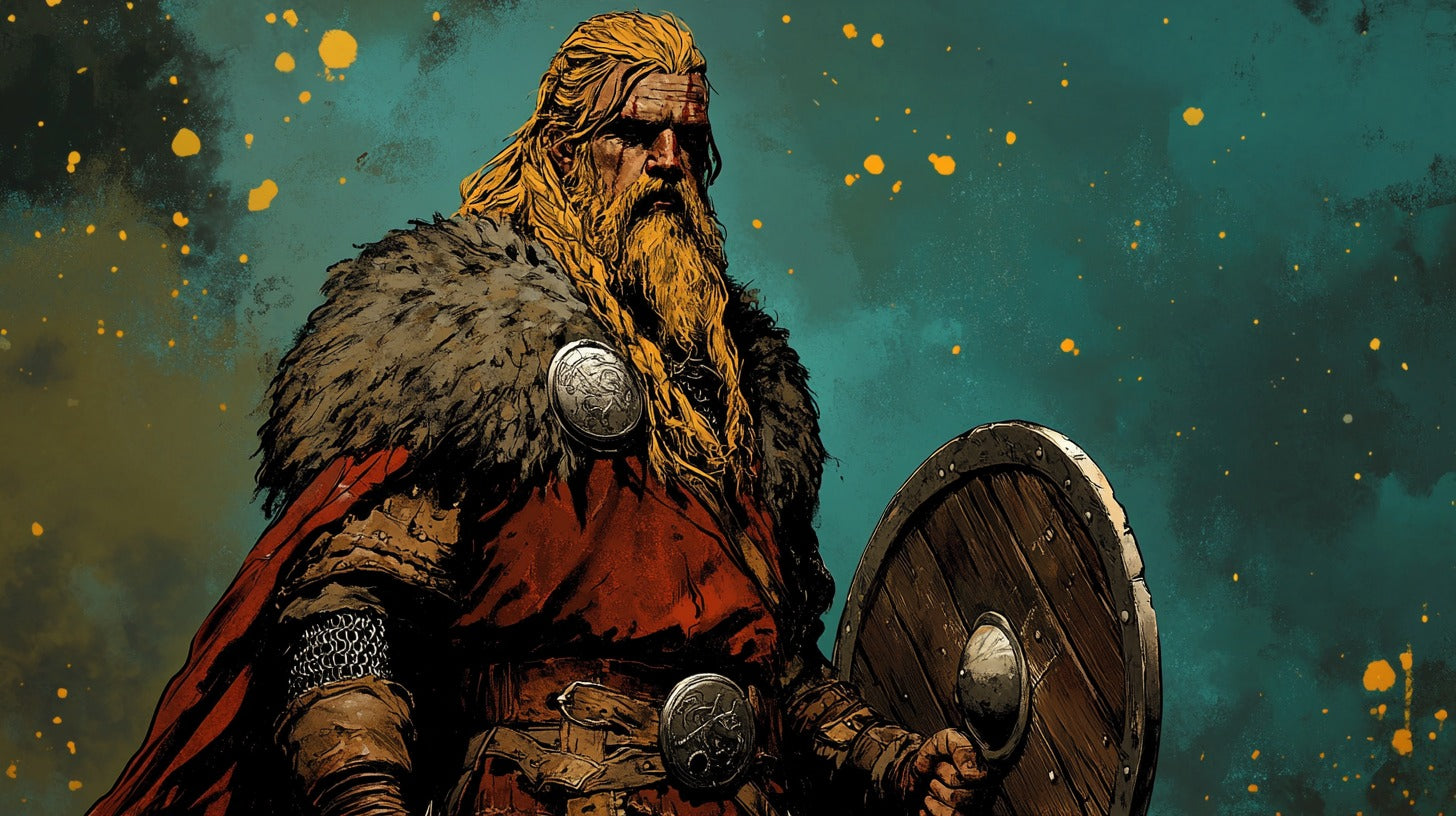
Shapeshifter, Trickster, Catalyst: The Many Faces of Loki
In the frost-kissed realms of Norse mythology, where gods and giants wage eternal war, there strides a figure as unpredictable as the northern winds. Neither wholly divine nor entirely monstrous, Loki the Trickster weaves through the tales of the Norsemen, leaving chaos and transformation in his wake.
Origins and Parentage

The Saptun stone is an ancient Viking-era artifact found in Sweden. It's notable for featuring an etched face believed by many scholars to be a rare depiction of Loki, the Norse trickster god.
Jötunn Heritage
Loki's origins are as complex as the god himself. Born of the giants, or Jötnar, he emerges from a lineage of chaos and primordial power. His father, Fárbauti, whose name means "cruel striker," hints at the destructive potential lying dormant in Loki's blood. His mother, Laufey (or Nál), shrouded in mystery, adds another layer to Loki's enigmatic beginnings.
Adoption by Odin
Yet, despite his giant heritage, Loki finds himself counted among the Æsir, the principal gods of Norse mythology. This paradoxical position stems from a blood brotherhood sworn with Odin, the Allfather himself. It's a bond that raises Loki to divine status while simultaneously setting the stage for the most tragic betrayal in Norse myth.
Loki's Physical Appearance and Abilities

Loki and Svaðilfari / Illustration: by Dorothy Hardy (1909)
Shapeshifting Powers
If you were to ask ten skalds to describe Loki's appearance, you might get ten different answers. For Loki, more than any other Norse god, is a master of transformation. He shifts from man to woman, from god to animal, each form as fluid as quicksilver and as changeable as the northern lights.
Cunning and Intellect
But Loki's true power lies not in his physical transformations, but in the razor-sharp wit and cunning that have earned him the title of Trickster God. His mind is a labyrinth of schemes and silver-tongued persuasions, capable of talking his way into - and out of - the most perilous situations.
Loki's Family

Loki's brood; Hel, Fenrir and Jörmungandr. The figure in the background is presumably Angrboða / Illustration: Emil Doepler
Sigyn and Their Children
In a pantheon rife with infidelity and complex relationships, Loki's marriage to Sigyn stands out for its steadfastness - at least on Sigyn's part. Their sons, Narfi and Vali, become tragic pawns in the gods' punishment of their father, a tale that underscores the often cruel nature of divine justice in Norse mythology.
Angrboða and the Monstrous Offspring
But it is Loki's liaison with the giantess Angrboða that produces his most infamous progeny. From this union spring three creatures so terrifying that they shake the very foundations of the Norse cosmos.
Fenrir the Wolf
First among these is Fenrir, the great wolf whose strength and ferocity strike fear even into the hearts of the gods. Raised in Asgard but ultimately bound by the dwarven-forged ribbon Gleipnir, Fenrir's fate is inextricably tied to Odin's, a ticking time bomb waiting for Ragnarök.
Jörmungandr the World Serpent
Next comes Jörmungandr, the World Serpent, a creature so vast it encircles Midgard, gripping its own tail in its maw. This monstrous offspring of Loki is destined to be both the nemesis and doom of Thor, the Thunder God.
Hel, Goddess of the Underworld
Last, but certainly not least, is Hel, the goddess of the underworld. Half beautiful woman, half decaying corpse, she rules over the realm of the inglorious dead, those who die of old age or disease rather than in battle.
Loki's Role in Norse Mythology

Borre Art Styled Loki Pendant (Historical Replica from the Varby Hoard)
The Trickster Archetype
Loki embodies the trickster archetype found in mythologies worldwide. Like Hermes in Greek myth or Anansi in African folklore, Loki serves as a catalyst for change, a breaker of rules, and a challenger of the established order. His presence injects chaos into the narrative, keeping both gods and mortals on their toes.
Catalyst for Change and Chaos
But Loki is more than just a troublemaker. His actions, for better or worse, drive the narrative of Norse mythology forward. Without Loki, there would be no magical items forged by the dwarves, no reason for Thor's journey to Jötunheim, and ultimately, no Ragnarök. He is the spark that ignites the fire of change, the pebble that starts the avalanche.
Famous Myths Involving Loki

Loki's flight to Jötunheim / Illustration: W. G. Collingwood (1908)
The Building of Asgard's Wall
One of the most famous tales involving Loki showcases both his quick thinking and his penchant for creating problems. When a giant offers to build an impenetrable wall around Asgard in exchange for the sun, moon, and the goddess Freyja, it's Loki who suggests the impossible deadline. And when the giant looks set to complete the task, it's Loki who transforms into a mare to distract the giant's stallion, ultimately saving the day but birthing Odin's eight-legged steed, Sleipnir, in the process.
The Theft of Iðunn's Apples
Another classic Loki tale involves the theft of Iðunn's apples of youth. Loki, captured by the giant Þjazi, promises to lure Iðunn and her apples out of Asgard. His successful trickery leads to the gods beginning to age, forcing Loki to undertake a daring rescue mission to retrieve both Iðunn and her precious apples.
The Death of Baldr
Perhaps the most infamous of Loki's deeds is his role in the death of Baldr, Odin's beloved son. Using his silver tongue, Loki discovers Baldr's one weakness - mistletoe - and manipulates the blind god Höðr into throwing a mistletoe dart at Baldr, killing him instantly. This act marks the beginning of the end for Loki, setting in motion the events that will lead to his punishment and, ultimately, to Ragnarök.
Loki's Punishment

Loki and Sigyn / Illustration: Mårten Eskil Winge (1863)
The Binding of Loki
The gods' retribution for Baldr's death is swift and terrible. Loki is bound with the entrails of his son Narfi, transformed into iron chains by the gods. A venomous serpent is placed above him, dripping caustic venom onto his face.
Sigyn's Devotion
In this horrific scene, we see a glimmer of loyalty and love. Loki's wife, Sigyn, stands by him, holding a bowl to catch the venom. But when she must empty the bowl, the venom falls on Loki, causing him to writhe in agony - an agony said to cause earthquakes in Midgard.
Loki's Role in Ragnarök

Breaking Free from His Bonds
Loki's binding is not eternal. The Völuspá, an Old Norse poem, prophesies that Loki will break free at the onset of Ragnarök, the twilight of the gods.
Leading the Forces of Chaos
Once free, Loki takes his place as a leader of the forces of chaos. He guides the ship Naglfar, made from the fingernails and toenails of the dead, bringing the armies of Hel and the giants to do battle with the gods.
Loki in Popular Culture

The bound figure on the Kirkby Stephen Stone, depicting Loki / Photo: Julius Magnus Petersen
Literature and Comics
Loki's complex character has inspired countless reinterpretations in modern literature and comics. From Neil Gaiman's "American Gods" to Marvel's Thor comics, Loki continues to captivate audiences with his wit, charm, and unpredictability.
Film and Television
The silver screen has embraced Loki with equal fervor. Tom Hiddleston's portrayal in the Marvel Cinematic Universe has brought the trickster god to a whole new audience, cementing Loki's place in popular culture.
Conclusion
Loki remains one of the most fascinating and complex figures in Norse mythology. Neither wholly good nor entirely evil, he exists in the grey areas, challenging our perceptions and forcing us to question the nature of order and chaos, loyalty and betrayal. His story is a reminder that even in a world of gods and monsters, it's often the most human characters - with all their flaws and contradictions - that captivate us the most.
As we reflect on Loki's tale, we're left to ponder: In a world that often demands conformity, isn't there a little bit of the trickster in all of us? And perhaps more importantly, don't we need that spark of chaos to truly appreciate the order in our lives?
FAQs
- Was Loki always considered a god in Norse mythology?
Loki's status is complex. While he's often counted among the Æsir gods due to his blood brotherhood with Odin, he's actually of Jötunn (giant) heritage. His position in the pantheon is ambiguous and often shifts.
- What are Loki's most famous children?
Loki's most famous children are Fenrir the wolf, Jörmungandr the World Serpent, and Hel, the goddess of the underworld. He also fathered Sleipnir, Odin's eight-legged horse, while in the form of a mare.
- Does Loki die in Ragnarök?
According to the prophecies, Loki is destined to fight Heimdallr during Ragnarök, and they are fated to slay each other.
- Why is Loki often associated with fire?
While Loki isn't specifically a fire god, he's often associated with fire due to his destructive and changeable nature. Some scholars also link his name etymologically to words meaning "flame" or "fire," though this is debated.
- Is Marvel's Loki accurate to Norse mythology?
While Marvel's Loki borrows many elements from Norse myths, it's a significantly altered version. The mythological Loki is not Thor's adopted brother, for instance, and his motivations and actions often differ from the comic and film character.
References
Sturluson, S. (13th century). The Prose Edda. Translated by J. L. Byock (2005). Penguin Classics.
Larrington, C. (Trans.). (2014). The Poetic Edda (2nd ed.). Oxford University Press.
Lindow, J. (2001). Norse Mythology: A Guide to the Gods, Heroes, Rituals, and Beliefs. Oxford University Press.
Gaiman, N. (2017). Norse Mythology. W. W. Norton & Company.
Orchard, A. (1997). Dictionary of Norse Myth and Legend. Cassell.







